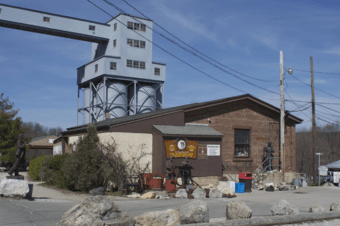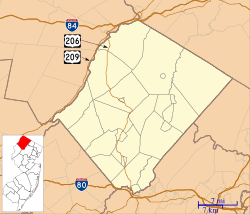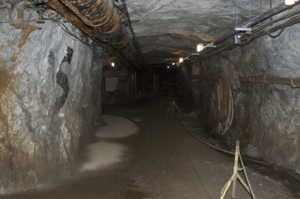Sterling Hill Mining Museum facts for kids
|
Sterling Hill Mining Museum
|
|
 |
|
| Location | 30 Plant Street, Ogdensburg, New Jersey |
|---|---|
| Architectural style | Industrial |
| NRHP reference No. | 91001365 |
Quick facts for kids Significant dates |
|
| Added to NRHP | September 3, 1991 |
The Sterling Hill Mining Museum is a fascinating place in Ogdensburg, New Jersey. It used to be a busy zinc mine, known as the Sterling Hill Mine. This mine was the very last underground mine to operate in New Jersey.
After closing in 1986, it reopened as a museum in 1990. The museum is famous for its amazing collection of minerals. Many of these minerals glow under special lights, a process called fluorescence. The mine was recognized for its importance and added to the National Register of Historic Places in 1991.
The Mine's Long History
People first started mining here way back in the 1630s. They thought they had found copper, but it turned out to be zinc. Over the years, the land changed hands many times.
In 1765, a man named Robert Ogden bought the property. Later, in 1897, several mines in the area joined together. They formed a big company called the New Jersey Zinc Company.
The mine kept working until 1986. It closed because of a disagreement about taxes with the town. In 1989, two brothers, Richard and Robert Hauck, bought the property. They had a great idea to turn the old mine into a museum.
The Sterling Hill Mining Museum officially opened its doors in August 1990. It has been teaching visitors about mining and minerals ever since.
Amazing Minerals and Geology
The rocks at Sterling Hill Mine are incredibly old. They formed about 1.15 billion years ago! These rocks started as limestone at the bottom of an ancient ocean. Over millions of years, they changed into the hard rock we see today.
The Sterling Hill Mine, along with the nearby Franklin Mine, is a mineral wonderland. More than 360 different types of minerals have been found here. That's about 10% of all the minerals known to science!
What's even cooler is that 35 of these minerals are found nowhere else on Earth. Also, 91 of the minerals found here can fluoresce. This means they glow with bright colors when special ultraviolet (UV) lights shine on them.
The mine has a huge network of tunnels, stretching for about 35 miles (56 km). The deepest parts go down to 2,675 feet (815 m) below the surface. Most of the lower tunnels are now filled with water. However, the upper parts are still open for visitors to explore. The mine stays at a cool 56 °F (13 °C) all year round.
Exploring the Museum
When you visit the Sterling Hill Mining Museum, your tour starts in the exhibit hall. Here, you can see many interesting things. There are old mining tools, beautiful mineral samples, and even fossils and meteorites.
After the exhibit hall, you get to walk into the mine itself. The tour takes you on a 1,300 foot (400 m) path through the upper tunnels. One special part is the Rainbow Tunnel. Here, short-wave UV lights are turned on. This makes the walls and mineral samples glow in amazing fluorescent colors. It's like walking through a rainbow!
The museum is also home to other cool attractions. These include the Ellis Astronomical Observatory, where you can learn about stars. There's also the Thomas S. Warren Museum of Fluorescence, dedicated to all things that glow. Plus, you can see a large collection of old mining equipment.
See also
- National Register of Historic Places listings in Sussex County, New Jersey
- Backwards Tunnel, another historic site near the mine.
- Ogden Mine Railroad







